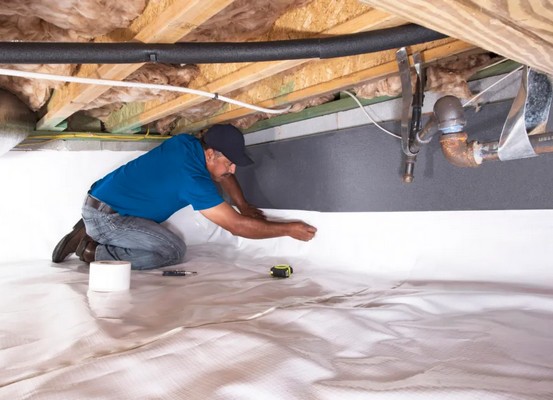
What is Crawl Space Encapsulation
You probably don’t want to think about what’s going on down there if your house is built over a crawl space. Crawl places are typically dark, filthy, and infested with creepy crawlies and bugs. But what if we told you there’s a technique to keep your crawl space not just clean and dry but also improve the air quality in your home?
Encapsulating your crawl space can help you get rid of moisture, vermin, mold, and mildew from beneath your house. Continue reading to learn more about how this works and why you require it
What Is Crawl Space Encapsulation?
A crawl space is a subterranean region beneath your property that functions similarly to the basement. It differs from a basement in that it has outside ventilation.
During the construction of a home, crawl space provides convenience and is affordable. The crawl space eliminates the necessity for a level concrete surface during construction. Crawl spaces can also be used to place HVAC equipment.
The procedure of lining your crawl space with heavy-duty polyethylene is known as crawl space encapsulation. The polyethylene barrier covers and seals your crawl space’s floors, walls, and, in certain situations, ceiling. This barrier is comparable to the lining seen in some swimming pools at home. The barrier sections are sealed and connected using heavy-duty sealing tape.
How Does It Work?
Cleaning out your crawl space is the first step towards encapsulating it. Depending on your scenario, this may entail bug eradication or simply vacuuming the area and eliminating any dirt lying below. Then, using double-sided seal tape, adhere the moisture barrier to the floor joists and foundation walls as uniformly as feasible.
Crawl space dehumidifiers are available that are built to withstand harsh, humid environments. You’ll need to install a dehumidifier once the moisture barrier is in place and thoroughly sealed to remove any moisture that does slip in. You might also want to invest in a remote humidity sensor, which allows you to check the conditions in your crawl space without climbing underneath the house.
Benefits Of Creating A Vapor Barrier
One of the critical advantages of crawl space encapsulation is that it improves the air quality in your home, as previously discussed. Mold and mildew are both dangerous to one’s health. You wouldn’t let a leaking sink in your house continue to run, and you shouldn’t let moisture build up in your crawl space either.
Insects, rodents, and other pests that may try to make their home in your crawl area may be deterred by vapor barriers. The climate in an encased crawl area is far less conducive for wood-destroying critters, which might help protect your home from damage.
Sealing Vs. Full. Encapsulation
The terms “crawl space encapsulation” and “crawl space sealing” are frequently interchanged. However, there is a distinction between the two: crawl space sealing is less comprehensive than encapsulation. It merely lines the crawl space floor and eight inches of the foundation walls, leaving a wide, vulnerable area at the top.
Crawl space encapsulation covers the entire inside of your crawl space, totally encapsulating it, as the name implies. Because heat loss through your crawl space is eliminated, this can help make your home more pleasant. Some businesses may even install insulation to walls and access doors to ensure that your space is as energy-efficient as feasible.
Who Should Encapsulate
Crawl Space Encapsulation services are a good idea for everyone who lives in a house with one. It’s worth it only for the insect avoidance, and the increased energy efficiency will pay for the installation in a few years.
On the other hand, crawl space encapsulation is especially crucial for those who live near significant bodies of water or at sea level. Mold and mildew thrive in dark, enclosed spaces like crawl spaces, and the dirt around your home may naturally have more moisture, making it easier for mold and mildew to flourish.
If you’ve seen evidence of mold or mildew in your home, or if you live with someone who suffers from allergies, you should get your crawl space enclosed. The cost of protecting your family’s health is well worth it.
Can You DIY
You might be wondering if crawl space encapsulation is as easy as taping some plastic to the walls, and if so if you can do it yourself. You can easily do your crawl space encapsulation, but we don’t suggest it. It’s not a fun job, so it’s worth hiring someone else to do it for you.
Crawling around beneath your house for a few days, taking out all the trash, and cleaning up the area is all part of DYing a crawl space encapsulation. Then you have to find out how to cover the aspects you’re crawling on with plastic. Crawl space dehumidifiers will almost certainly require a pump and a drain line, which entails plumbing work you might not want to do yourself.
Concluding Thoughts!
Before you encapsulate your crawl space, you should consider a few things. If there’s any standing water in your crawl area, you’ll need to address it first. Plastic and dehumidifiers can only go so far.
Crawl space encapsulation is a terrific way to enhance indoor air quality, increase energy efficiency, and protect your house from harm.
Atlantic Foundation & Crawl Space Repair can take care of all of your home repair needs. We’re known for trustworthy advice, high-quality products, and knowledgeable service in foundation repair, crawl space encapsulation, basement wall repair, structural repair, and many more. We assist homeowners in transforming their homes while enhancing their value.
Forget about crawl space and foundation damage by requesting our professionals’ crawl space encapsulation examination today. Contact us now!
